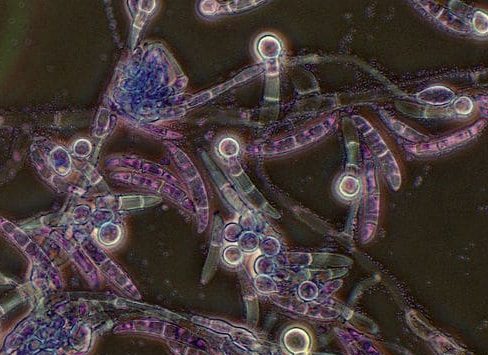Are you interested to know how to control Pythium? Pythium also referred to as damping-off, is a disease that attacks the base or the root structure of plants. It is important to be ready to easily spot symptoms and provide solutions if you think that your crop is infected with Pythium.
There are several different species of Pythium, but all of them prefer to prey on younger plants or seedlings. If your plants have been affected by Pythium, it can negatively affect the germination rate of your seeds. Pythium affects the bottom of the stem and soil point of intersection and symptoms include wilting and yellowing of leaves. Inspect the soil lines to ascertain if there’s a condition like this.

Pythium is rarely found in soilless mixes, however, can easily be spread by growers who are using dirty tools from an infected area.
Ways Pythium Can Be Introduced in Your Seedlings
The pathogens (molds and fungi) responsible for spreading Pythium thrive in soil and its debris. Here are some of the ways damping off or Pythium can infiltrate your plants:
Using pots and tools that haven’t been properly cleaned can be the carrier of pathogens.
Fungus gnats, splashing irrigation water, and other insects can easily carry the harmful spores of Fusarium spp. to other plants.
Contaminated tools, dirty hands, and hose ends that were in contact with contaminated dirt and debris can also spread Pythium.
How to Prevent Pythium
Unfortunately, there’s no turning back for plants that have been affected by Pythium, but you can take proactive steps to prevent it from affecting your plants.
Tip #1: Keep your tools and containers clean and sterile
This is often to stop your crops from being infected due to unclean handy tools getting used from infected site or areas, into areas which aren’t yet infected by Pythium.
Tip #2: Use strain filters
For flood and drain setups, a strain filter is suggested to stop dirty water from flowing into the reservoir which could carry various diseases.
Tip #3: Use fungicides
Fungicides are an effective way to prevent damping off, but make sure to use them with caution. Follow label instructions to prevent it from harming your plants.
Tip #4: Use cinnamon
Cinnamon has anti-fungal properties and if you sprinkle it on top of your seeds before it germinates, it will create an anti-fungal barrier which can prevent the spread of Pythium.
Tip #5: Implement strict sanitation methods
Even if you treat the soil with fungicide or other preventive treatments, poor sanitation practices can reinfest treated soil with these pathogens.
Tip #6: Implement proper soil preparation and management
It’s important to provide proper soil drainage, ventilation, water-holding capacity, and plant nutrition. Be sure to add fertilizer and lime based on the soil test report to achieve the best results.
Pythium Blight: A Common Type of Pythium
Since Pythium blight is a common type of Pythium, people have different names for it such as grease spot, or cottony blight. Others also call it spot blight. In most cases, the grass gets affected by Pythium blight when the humidity levels are extremely high during the summer.
Additionally, this disease becomes more apparent when the temperatures during the daytime reach over 85 degrees Fahrenheit and when temperatures at night drop to about 20 degrees Fahrenheit. Grasses that thrive in cooler seasons are more vulnerable to Pythium blight than grasses that prefer warmer seasons. For this reason, one of the best ways to minimize your grass’s chances of catching Pythium blight is by giving your grass treatment a few tweaks and by resorting to fungicides.
Pythium blight is attracted to areas where humidity is high and water is left sitting on the grass for 12 hours or more. That greasy appearance is why the disease is usually called a “greasy spot”. Sometimes, cottony growth can also appear. This is often the fungus’ mycelium, it’s like a rootage.
After these initial symptoms, the grass dies and there’s a brown patch on the lawn. Don’t water your grass too much to prevent water from sitting too long on the soil. Water your grass early in the morning so it has all day for the soil to soak up the moisture. Watering deeply and seldomly is usually better than frequent, shallow watering to prevent Pythium blight from affecting your grass.
How to Control Pythium in Your Greenhouse
There are certain things you can do to prevent Pythium from preying on your plants. Here are some of the tips you need to remember:
Tip #1: Disinfect
Disinfect the nutrient solutions that are recirculating in your greenhouse.
Tip #2: Use higher substrate blocks
Widen the distance between the primary substrates by using higher substrate blocks for your seedlings.
Tip #3: Ensure warmth and proper drainage
Keep your plants warm and toasty after planting. Be sure that your plants have good drainage and the water for irrigation should be lukewarm.
The Benefits of Growing Plants in a Semi pro Greenhouse
There are several benefits of growing your plants in a semi pro greenhouse. For instance, it helps prevent insect infestation and infectious diseases from spreading between plants. It also keeps your plants safe from bad weather conditions. Keeping them in an enclosed space lowers the risk of inclement weather, pests, and diseases from affecting your plants.
Final Thoughts on How to Control Pythium
Now that you know how to control Pythium and how damping-off can affect your plants, you’ll be able to successfully prevent it from happening to your plants. Just make sure your plants are grown in ideal environments and you wouldn’t have to worry about Pythium.
